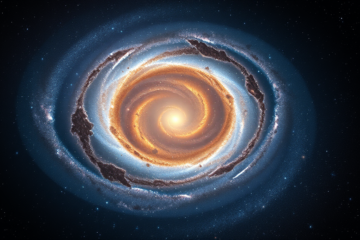NASA Sends Astronauts to Artemis II Lunar Mission
Lunar mission It is a topic that has aroused interest and curiosity over the decades, especially with recent advances in space exploration.
In this article, we will explore the Artemis II mission, scheduled for February 2026, which will feature astronauts traveling around the Moon.
Lasting ten days, this mission will serve as a crucial step toward the future lunar landing in 2027. We'll examine the preparations, challenges, and objectives surrounding this ambitious endeavor, highlighting the importance of the scientific experiments conducted during the trip and the technical challenges NASA faces for Artemis III's success.
Artemis II Overview
NASA's Artemis II mission represents a significant historic and technical milestone in space exploration.
Planned for February 2026, it will perform a flight around the Moon in ten days with a crew of four astronauts.
This will be the first group to travel beyond low Earth orbit since 1972.
The mission aims to travel to 9.2 thousand km of the lunar surface, which highlights its complexity and importance in paving the way for the future lunar landing planned for 2027.
Artemis II will play a crucial role in testing the exploration systems developed for the next phase.
As mentioned in the NASA's official website, astronauts will carry out various scientific experiments to monitor the impacts of space on their bodies.
During this mission, important technical analyses will also be carried out to ensure the safety of future lunar landings.
To summarize, Artemis II is relevant as it provides the experience needed for more complex missions.
- The first manned journey beyond low Earth orbit
- Demonstration of NASA's technological advances
- Preparing for the future lunar landing in 2027
Main Technology and Equipment
The Space Launch System (SLS) and the Orion capsule play crucial roles in the Artemis II mission, which is preparing to send astronauts around the Moon in 2026. Both technologies were validated in 2022 during an uncrewed flight, ensuring that all systems are ready for the demands of a crewed mission.
These tests are essential to ensure the safety of astronauts in the next stages of lunar exploration, as any failure during re-entry or during flight could have serious consequences.
Space Launch System (SLS)
O Space Launch System (SLS) is one of the pillars of NASA's Artemis program.
Its robust design provides the thrust needed to send the Orion capsule and its crew toward the Moon.
The SLS is a combination of power and precision engineering, with highly efficient propulsion stages that ensure successful takeoff.
The rocket's core stage is equipped with RS-25 engines, providing considerable force to overcome Earth's gravity.
Furthermore, the payload capacity of the SLS is optimized to carry not only Orion, but also other mission-critical equipment.
In short, the SLS continues to be an exemplary demonstration of technological innovation in the field of astronautics.
Orion Capsule and the Lessons of the 2022 Flight
The Orion capsule, after the 2022 unmanned flight, underwent important improvements based on data obtained during the mission.
One of the highlights is the life support systems, which have been optimized to ensure the safety and well-being of future astronauts on subsequent missions.
Furthermore, the heat shield, essential for atmospheric reentry, received improvements to mitigate the identified problems, as detailed in an article by Space Today.
Finally, the command interface has been improved, providing more effective communication and better response to commands, ensuring the success of future missions.
Scientific Experiments and Crew Health
During the Artemis II mission, astronauts will be at the center of crucial scientific experiments that will assess the impact of prolonged spaceflight on the human body.
Physiological monitoring will include measuring vital parameters such as heart rate and blood pressure using state-of-the-art sensors.
This data will provide insights into the body's reactions to the space environment.
To enrich the study, the team will collect biological samples, analyzing health markers that may indicate physiological changes.
These experiments are vital to preparing for future long-duration missions and ensuring crew safety.
The mission will use cutting edge technology to measure radiation exposure, one of the biggest challenges of spaceflight.
During the mission, astronauts will be equipped with specific sensors to detect radiation levels, ensuring that cumulative effects are monitored in real time.
By understanding how radiation affects health, NASA can develop effective mitigation strategies.
- Blood oxidation analysis
- Bone density monitoring
- Immune response test
- Muscle wasting measurement
These measures are an integral part of the ongoing effort to understand and overcome the challenges of space travel.
Reentry Challenges and Relationship to the Artemis III Schedule
The atmospheric reentry of the Artemis II mission will be a crucial moment, standing out as one of the most critical phases of the project.
The main focus is to test the Orion capsule's heat shield, which is essential for withstanding the intense temperatures generated upon re-entry into Earth's atmosphere.
Furthermore, deceleration forces need to be carefully controlled to ensure crew safety.
Limited room for error requires impeccable safety margins.
It is essential to remember that NASA's technical and financial challenges are substantial.
The Artemis III timeline, which targets a lunar landing in 2027, depends directly on the success of this test phase, indicating that any failure in Artemis II could cause significant changes to future timelines.
According to experts, the current schedule is optimistic due to the complexity of the challenges faced, and requires careful attention to every detail.
Learn more about the Artemis II mission on NASA's website.
Reentry will be the most critical point of the mission, says engineer X
.
In summary, the Artemis II mission represents a significant milestone in lunar exploration, paving the way for humanity's future beyond Earth.
Despite the challenges, NASA's determination to move forward with Artemis III underscores its commitment to space exploration.



0 Comments